To cold-smoke fish like the pioneers, you'll need fresh, high-fat fish like salmon or trout, and hardwoods such as maple, oak, or hickory. Start by brining your fish in a solution of 1 part salt to 7 parts water for several hours. Let it develop a pellicle (tacky surface) by air-drying before smoking. Keep your smoking temperature below 85°F – pioneers used ice or distance from the fire to manage heat. Smoke for 12-24 hours while maintaining consistent smoke density. When done properly, your fish will have a delicate, smoky flavor and can last for months using traditional preservation methods. These time-tested techniques hold even more secrets to perfect cold-smoking.
Understanding Cold Smoking Fish

The art of cold smoking transforms fresh fish into a delicately flavored delicacy through a precise combination of brining, drying, and smoking at low temperatures. Unlike hot smoking, which cooks the fish, cold smoking occurs below 30°C to preserve the fish's texture while infusing it with a distinctive smoky flavor.
You'll need to start with high-quality fish and prepare it properly by cleaning it thoroughly to remove blood and slime. Cut your fish into uniform pieces to guarantee even salt absorption during the brining process. Fish fillets should be kept to no more than 2cm in thickness for the best results.
You'll create a strong brine solution using 1 part salt to 7 parts water, and you can enhance the flavor by adding brown sugar or other seasonings.
After brining, you'll need to develop a pellicle – a dry, tacky surface that allows smoke to adhere properly. This essential step involves patting the fish dry and refrigerating it for 24 hours.
The actual smoking process takes 12 to 24 hours, during which you'll maintain specific humidity levels – starting at 90% and gradually reducing to 70%. Remember, you're not cooking the fish; you're preserving it through a careful balance of salt, drying, and smoke.
Essential Tools and Equipment
Your smoking chamber can be as simple as a converted refrigerator or metal trash can, equipped with proper ventilation controls at the top and bottom for ideal airflow.
You'll need a reliable thermometer to maintain temperatures between 60-80°F, along with a pellet tube or wood chip smoker to generate consistent smoke. Proper temperature monitoring is essential for cold smoking success, as maintaining the correct range prevents cooking while allowing the smoke to properly penetrate the fish.
For traditional wood selection, stock up on hardwoods like maple, oak, or hickory while avoiding resinous woods such as pine or cedar that can impart unpleasant flavors.
Basic Smoking Chamber Setup
Setting up a proper smoking chamber requires several essential tools and pieces of equipment to achieve the best results.
You'll need an outdoor grill or smoker that provides consistent heat and a controlled environment. Make sure your chamber has adjustable vents at both the top and bottom to regulate smoke flow and temperature effectively.
Start by placing your metal rack inside the chamber – this is where you'll position your fish above the wood chips. Line the bottom with foil trays to catch drips and hold your smoking materials. Salt and sugar brining helps prepare the fish for optimal smoking results.
You'll want to use hardwood chips like maple, oak, or fruit woods for the best flavor profile. Create smoke packets by wrapping wood chips in aluminum foil and poking holes to release the smoke gradually.
Install your meat thermometer to monitor the internal temperature of your fish, ensuring it reaches 160°F for food safety. If you're using a traditional wood heat source, maintain a low, clean flame.
Position your grill mesh or skewers to keep fillets spread open, maximizing smoke exposure. Remember to check that your ventilation is adequate – keep windows open if smoking indoors to prevent smoke buildup.
Temperature Control Equipment
Mastering temperature control requires specific equipment designed for cold-smoking success.
You'll need reliable thermometers to monitor the coldest parts of your fish, guaranteeing temperatures stay below 30°C (86°F) to prevent accidental cooking. Modern WiFi meat thermometers with temperature alarms offer precise control and convenience, while HACCP data loggers help you track and store temperature readings every 4 hours.
For consistent results, consider investing in automated control systems that maintain ideal conditions. The Pesciugatore® climate-controlled chambers come with built-in sensors for temperature, humidity, and pH monitoring, while SFC® controllers let you create custom smoking programs.
Here's essential temperature control equipment you'll need:
- Multiple thermometers: One for the smoking chamber, one for the fish's core, and one for ambient room temperature
- Temperature data logger or WiFi-enabled monitoring system to track conditions throughout the process
- External firebox or heat sink to manage excess heat before it reaches your product
- Cold smoke adapter with ice setup for maintaining lower temperatures, especially during warmer weather
Remember to keep your storage area at or below 3°C (37°F) after smoking to guarantee food safety and extend shelf life.
Traditional Wood Selection Tools
Choosing the right tools for wood selection and preparation makes all the difference in cold-smoking success. You'll need an electric planer as your primary tool for creating consistent wood shavings, which allows you to control the size and thickness of your smoking material. When preparing wood for fish smoking, you'll want to focus on hardwoods and fruitwoods while avoiding softwoods entirely.
| Tool Type | Primary Use | Best Woods |
|---|---|---|
| Electric Planer | Creating fine shavings | Oak, Maple, Apple |
| Industrial Vacuum | Collecting wood chips | Cherry, Pecan, Hickory |
| Storage Bags | Maintaining moisture | Fruitwoods, Hardwoods |
| Moisture Meter | Testing wood readiness | All smoking woods |
Your electric planer's blade depth setting is essential for achieving the right size shavings. Set it shallow for fine shavings that'll burn slowly and produce clean smoke. You'll want to collect these shavings using an industrial vacuum cleaner for efficiency and cleanliness. Store your prepared wood shavings in sealed plastic bags to maintain proper moisture content. For fish smoking, apple and cherry woods are your best choices, as they provide a subtle sweetness without overpowering the delicate fish flavors.
Selecting The Right Fish
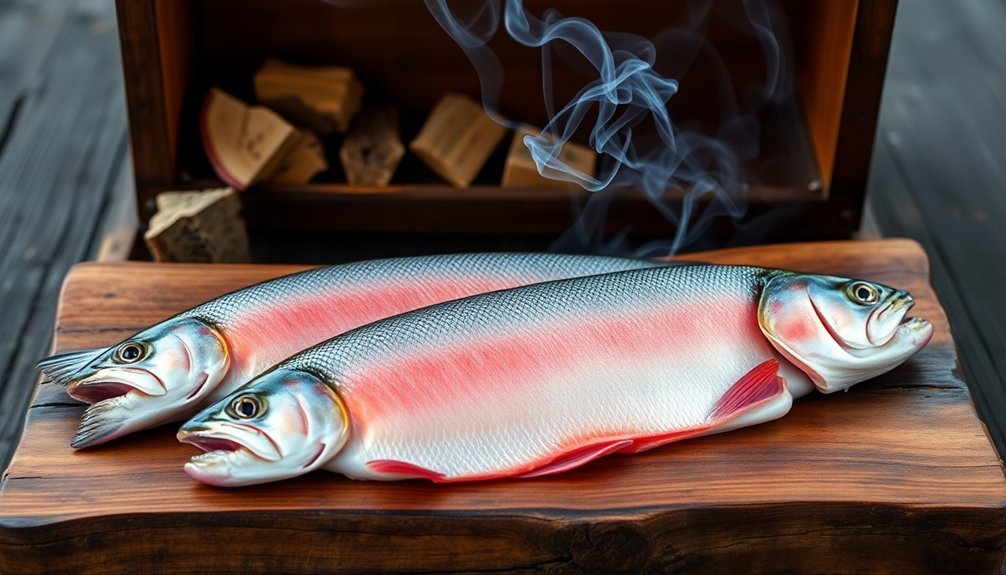
When selecting fish for cold smoking, you'll want to start with either fresh, high-quality fish or flash-frozen options that maintain their firm texture and pleasant aroma.
Fat content plays a vital role in the smoking process, with fatty fish like King salmon or Atlantic salmon producing the most flavorful results since the fats absorb smoke particles effectively.
While salmon is the traditional choice, you can successfully cold-smoke various local species including black cod, trout, or herring, provided they're properly prepared and suited to the smoking process.
Fresh Vs Frozen Options
The decision between fresh and frozen fish is vital for successful cold smoking. While fresh-caught fish might seem like the ideal choice, freezing your fish before smoking is actually the safer option. This important step kills harmful parasites that could survive both brining and cold smoking processes.
If you're using fresh fish, you'll need to freeze it at 0°F for at least two weeks before smoking. Your home freezer may take several days to reach this temperature throughout the entire fish, especially with larger pieces. Remember to keep fresh fish below 38°F before freezing to prevent bacterial growth, and always clean and dress it properly.
- Keep fresh fish wrapped in plastic or aluminum foil and stored below 40°F until you're ready to freeze it.
- Package your fish in meal-sized portions before freezing for more efficient use.
- Label and date all packages to track freezing duration.
- Consider borrowing or renting additional freezer space if you need to freeze large quantities quickly.
Don't skip the freezing step when cold-smoking fish – it's vital for food safety since cold smoking doesn't cook the fish, leaving it vulnerable to parasites and bacterial growth.
Fat Content Matters
Success in cold smoking heavily depends on selecting fish with adequate fat content. You'll find that fish with higher fat content, like spring Chinook and summer steelhead, smoke more evenly and are more forgiving if you accidentally overcook them. They'll retain moisture better during the smoking process, much like bacon does when cooked.
When you're choosing fish for cold smoking, look for bright specimens caught from saltwater, particularly early-run spring Chinook. These fish typically have higher fat deposits, which make them ideal candidates. You'll want to avoid fall salmon and winter steelhead, as their lower fat content means they'll dry out more easily during smoking.
Fat content doesn't just affect the smoking process – it influences the final product's texture, flavor, and overall quality. If you're using frozen fish, be aware that higher fat content can lead to a softer texture in cold-smoked salmon. However, the fat helps distribute smoke flavor more evenly throughout the meat, and you'll get better results using an insulated smoker.
Local Species Selection
Selecting the right fish species makes a significant difference in your cold-smoking results. While King salmon stands out as the premium choice due to its high fat content and rich flavor profile, you'll find several other excellent options depending on your location and local availability.
If you're on the East Coast, you'll likely have easier access to Atlantic salmon, which works well despite having a slightly milder taste than King salmon.
For the best cold-smoking results, consider these top species:
- King (Chinook) salmon – ideal choice with ideal fat content and flavor
- Atlantic salmon – readily available and reliable for smoking
- Coho salmon – works well when properly dry-cured, despite being leaner
- Sablefish (black cod) – excellent alternative with unique buttery texture
Don't limit yourself to just salmon. If you're near traditional European markets or specialty shops, you might find mackerel, herring, or trout suitable for cold smoking.
Whatever species you choose, verify it's fresh or properly flash-frozen, with firm flesh and no signs of spoilage. Your fish should smell clean and ocean-fresh, with plump, undamaged flesh.
Traditional Brine Solutions
Before smoking your fish, preparing a proper brine solution sets the foundation for exceptional results. You'll need to start with a base of water, typically between 1 quart to 1 gallon, depending on the amount of fish you're processing.
Add non-iodized salt and sugar in equal ratios, using 1/4 to 1 1/3 cups of salt and 1/2 to 2/3 cups of sugar.
To enhance flavor, you can incorporate additional ingredients like lemon juice, garlic, pickling spice, or even spirits such as Scotch or bourbon.
You'll want to boil some of the water with the salt and sugar until they're completely dissolved, then add cold water to cool the mixture to room temperature before use.
The brining process requires careful attention to time and temperature. Keep your fish in the brine for 1.5 to 24 hours, depending on fillet thickness, and always brine in the refrigerator to prevent bacterial growth.
You can store unused brine solution for up to five days in the refrigerator. This process not only adds flavor but also helps preserve the fish and creates a more uniform texture in the final product.
Fish Preparation Steps
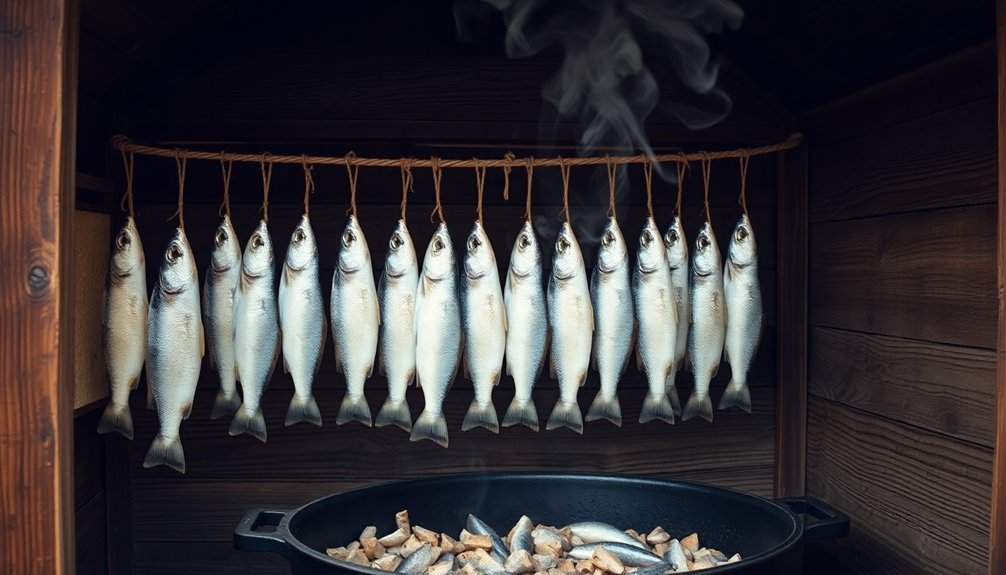
Proper fish preparation involves four critical stages: selection, cleaning, curing, and drying. You'll want to start with high-quality fresh or frozen fish, particularly fatty varieties like salmon or kingfish.
Before anything else, thoroughly clean your fish by removing all bones, scales, and impurities. For salmon, don't forget to extract those pesky pin bones using pliers.
Before you begin the cold-smoking process, you'll need to complete these essential preparation steps:
- Freeze your fish completely if you're planning to cold-smoke it without cooking, as this kills potential parasites that could be harmful.
- Cut your fish into thick portions, keeping the skin on for varieties like kingfish to maintain moisture during smoking.
- Calculate your salt and sugar mixture at 12% of your fish's total weight, then cure it in the refrigerator for 48 hours.
- After curing, rinse the fish thoroughly and let it dry uncovered in your refrigerator for 4-24 hours to develop a tacky surface called a pellicle.
Once you've completed these steps, let your fish reach room temperature before placing it in your smoker. This prevents unwanted condensation and guarantees even smoking.
Creating Your Smoke Box
With your fish now properly prepared, it's time to build your smoke box. You'll need to start with the frame, using square timber secured with wood screws for stability. Cover the sides with tongue-and-groove cladding or plywood, working from floor to top, including the sloped roof sections.
| Component | Basic Option | Premium Option |
|---|---|---|
| Body | Cardboard Box | Wood Frame |
| Shelving | Metal Cooling Rack | Steel Racks |
| Heat Source | Electric Hotplate | Fumotic® System |
| Smoke Control | Pie Plate with Holes | SFC® Controller |
| Monitoring | Basic Thermometer | HACCP Logger |
For a budget-friendly version, you can use a heavy-duty cardboard box with disposable roasting pans and cooling racks. Secure metal rods or dowels with fabric tape to create shelving levels. If you're building a permanent structure, you'll want to install proper catches for doors and ventilation covers. Don't forget to cut the slope of the top after completing the side cladding. For commercial needs, consider investing in a Pesciugatore® chamber with integrated temperature and humidity controls, plus LED lighting for ideal visibility.
Wood Selection For Cold Smoking
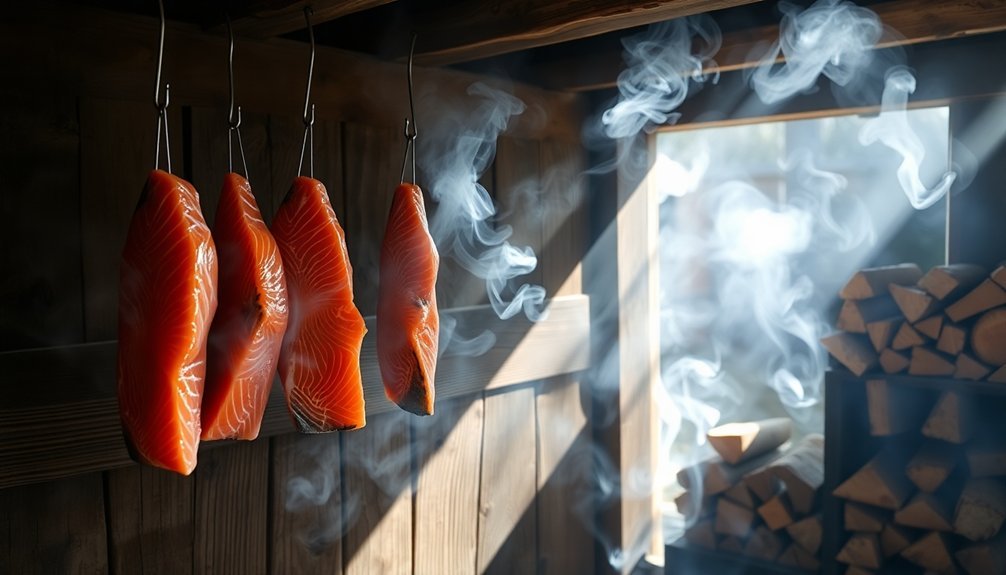
Selecting the right wood for cold smoking is vital to achieving the perfect flavor profile in your fish. The type of wood you choose will greatly impact the final taste, so it's important to match the wood with your specific fish variety. For delicate white fish like halibut or catfish, you'll want to stick with milder woods such as maple or fruit woods, while robust fish like tuna can handle stronger woods like hickory.
- Alder wood is your safest bet for most fish types, offering a mild, consistent smoke that won't overpower the natural flavors. It burns slowly and evenly, making it perfect for long smoking sessions.
- Cedar wood provides an excellent natural aroma and clean burn, pairing particularly well with salmon and trout.
- Fruit woods (apple, cherry, maple) deliver a sweet, mild smoke that's ideal for cold smoking without overwhelming the fish.
- Hickory and mesquite should be used sparingly, as their strong flavors can quickly overpower your fish – they're best reserved for darker fish varieties like tuna or mackerel.
Remember to moisten your wood slightly before use to facilitate proper combustion and prevent harsh flavors from developing.
Temperature Control Methods
While choosing the right wood sets the foundation for flavor, maintaining precise temperature control is the heart of successful cold smoking. You'll need to keep temperatures between 70-90°F (21-32°C) to avoid accidentally cooking your fish. Use a pellet tube smoke generator for the most consistent results, and monitor your smoker's temperature carefully with a reliable meat thermometer.
| Temperature Range | Control Method |
|---|---|
| Below 38°F | Refrigerate fish before and after smoking |
| 70-85°F | Ideal smoking temperature for best results |
| 85-90°F | Add ice to cool smoke if needed |
| Above 90°F | Avoid – will begin cooking the fish |
Before you start smoking, freeze your fish at 0°F for at least two weeks to eliminate parasites. Once you're ready to smoke, verify your smoker has enough space between fish pieces for proper smoke circulation. If you're using a traditional smoker, you might need to add ice to keep temperatures down. Don't overcrowd the smoker, as this can lead to uneven smoking and potential bacterial growth. After smoking, immediately refrigerate your fish to prevent bacteria from developing in the danger zone between 40-140°F.
Monitoring The Smoking Process
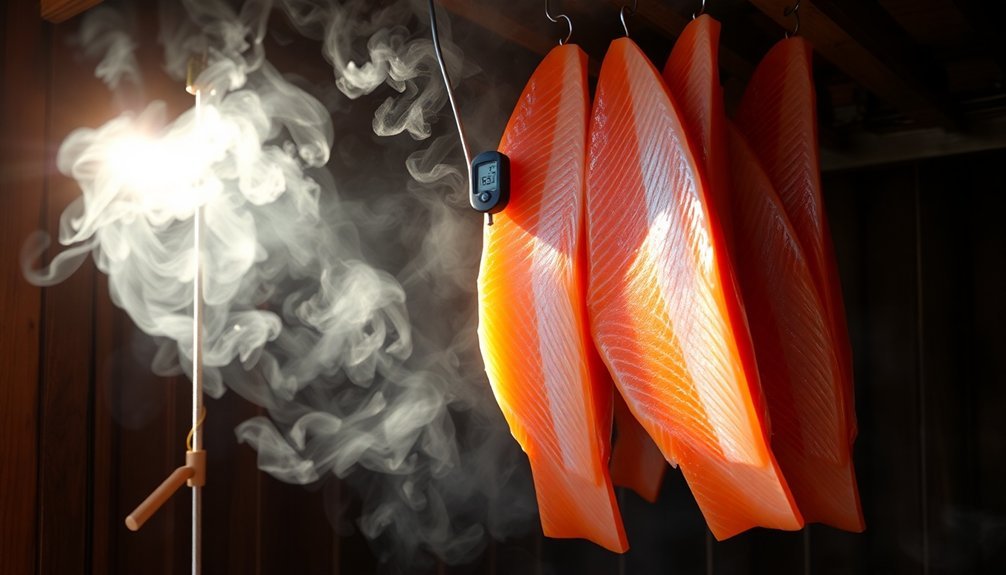
You'll need to consistently watch your smoke density throughout the cold-smoking process, ensuring there's enough smoke to flavor the fish without overwhelming it.
Keep checking multiple temperature points in your smoker to maintain even heat distribution and avoid hot spots that could partially cook the fish.
Your temperature readings should stay below 85°F to achieve proper cold smoking, with careful monitoring of both the smoke chamber and the fish's internal temperature.
Smoke Density Control
Successful cold-smoking requires careful monitoring of smoke density throughout the entire process. You'll need to maintain precise control over smoke application to guarantee proper phenolic compound concentration while avoiding excessive PAH contamination.
Using indirect smoking methods or smoke condensate from reliable sources will help you reduce harmful PAH levels while still achieving the desired smoke flavor and preservation effects.
To properly manage smoke density, you'll want to focus on applying smoke at vital stages, particularly during pellicle formation. The phenolic compounds in the smoke act as natural preservatives, inhibiting harmful bacteria and spores, so you'll need to ascertain adequate smoke penetration beneath the pellicle.
Here are key steps for controlling smoke density:
- Start with indirect smoking or electrostatic methods to minimize PAH contamination while maximizing smoke compound effectiveness.
- Apply smoke consistently before, during, and after pellicle formation to achieve proper phenolic compound concentrations.
- Consider using an atomizer for liquid smoke application, which gives you better control over smoke density.
- Monitor smoke levels to comply with EU regulations for benzopyrene and PAH4 limits in your finished product.
Temperature Check Points
Effective temperature monitoring forms the backbone of successful cold-smoking operations.
You'll need to maintain temperatures between 68-86°F (20-30°C) throughout the smoking process, which typically runs 6-12 hours. Using a reliable thermometer, check the coldest part of your fish regularly to guarantee you're staying within this vital range.
You'll want to track both temperature and humidity levels. Start with 90% relative humidity, then reduce it to 70% as the process continues. It's essential to use a thermometer with alarm capabilities, like a ThermaQ, to alert you if temperatures drift outside the safe range.
Remember, you're working in the danger zone for bacterial growth (70-100°F), so precision is key.
Don't rely on visual cues alone. Check your thermometer readings frequently and adjust your heat source as needed to maintain consistent temperatures. You're aiming for uniform drying and proper color development, which only happens with careful temperature control.
After smoking, immediately cool your fish and store it at or below 3°C. This careful monitoring guarantees you'll produce a safe, high-quality product that can last up to 21-49 days when properly stored.
Testing For Doneness
Testing for doneness in cold-smoked fish differs markedly from hot smoking since you're not cooking the product to a specific internal temperature. Instead, you'll need to monitor several factors throughout the process to guarantee proper smoking and food safety. Your primary focus should be maintaining temperatures below 90°F (32.2°C) while achieving the desired texture and flavor profile.
To determine if your fish is properly cold-smoked, check these essential indicators:
- Internal temperature shouldn't exceed 90°F (32.2°C) at any point – use your meat thermometer in the thickest part of the fish to verify this consistently.
- Surface texture should be slightly tacky but not wet, with the desired color development from smoke exposure.
- Processing time should typically fall between 16-24 hours, though some products may require up to 7 days.
- Relative humidity should start at 90% and gradually decrease to 70% as the process continues.
Safe Storage Methods

Properly stored cold-smoked fish will reward you with weeks of delicious meals, but careful attention to temperature control is essential. You'll need to store your smoked fish at temperatures below 38°F (3.3°C) to prevent harmful bacteria and botulism from developing. When you're storing in the refrigerator, make sure it maintains consistent temperatures throughout.
For refrigerated storage, your lightly salted and smoked fish can last 10-14 days when properly wrapped. Keep monitoring the storage conditions to prevent bacteria growth and histamine formation that could make you sick.
| Storage Method | Temperature | Duration |
|---|---|---|
| Refrigeration | Below 38°F | 10-14 days |
| Freezer – Short | 0°F | 2-3 months |
| Freezer – Long | Below 0°F | 4-6 months |
| Vacuum Sealed | Below 38°F | 2-3 weeks |
| Ice Storage | 32-34°F | 5-7 days |
Remember to check any store-bought smoked fish labels for proper storage instructions. They should clearly state "Keep Refrigerated at 38°F/3.3°C or less." When freezing your smoked fish, wrap it tightly in freezer paper or aluminum foil to protect against freezer burn and maintain quality.
Pioneer Smoking Wisdom
Traditional cold smoking is a time-honored craft that early settlers perfected through generations of trial and error. You'll find their time-tested wisdom invaluable when creating your own smoked fish.
The pioneers knew that proper brining was essential, using a mixture of 500g salt and 250g brown sugar per liter of water, allowing the fish to cure overnight before smoking.
The pioneers favored simple but effective smoking structures, often using a tipi-style setup or basic smokehouse with the fish hung on hooks above a smoldering fire. They understood that small pieces of wood, particularly manuka, produced the best results while avoiding bitter flavors from leaves or grasses.
Here's what the pioneers knew about successful cold smoking:
- Keep temperatures below 90°F (32°C) for proper preservation
- Replenish wood every 2.5-3 hours to maintain consistent smoke
- Smoke for 22-24 hours to achieve traditional results
- Monitor the fish's condition regularly throughout the process
Their method required patience, with smoking times ranging from half a day to several days, depending on the desired dryness.
You'll know your fish is ready when it reaches your preferred texture and firmness.
Frequently Asked Questions
Can I Use an Electric Smoker for Traditional Cold Smoking Methods?
Yes, you can use an electric smoker for cold smoking if it's equipped with proper attachments and temperature controls. You'll need to make certain it maintains temperatures between 65-85°F and has good airflow.
How Do Changes in Humidity Affect the Cold Smoking Process?
Changes in humidity directly affect your smoking results. You'll need 75-85% humidity to prevent your meat from drying out. If it's too dry, you'll get tough meat; too wet, and you risk bacterial growth.
What Indigenous Smoking Techniques Were Used Before European Settlement?
You'll find indigenous peoples used hollow logs and open fires with specific woods like hickory and alder. They'd cure fish with salt, smoke it for days, and often perform this preservation method as a communal activity.
Does Cold-Smoked Fish Need to Be Cooked Before Eating?
No, you don't need to cook cold-smoked fish before eating it. As long as it's been properly brined and smoked under safe conditions, it's ready to eat. Just verify it's been refrigerated properly throughout the process.
Can I Cold Smoke Fish During Summer Months in Warmer Climates?
While you can cold smoke in summer, it's challenging and risky. You'll need special cooling methods like ice trays and fans to maintain temperatures below 30°C. It's safer to wait for cooler seasons.
In Summary
You've now mastered a time-honored tradition that connects you directly to pioneer skills. When you're cold-smoking fish, you're not just preserving food – you're practicing a craft that sustained generations before us. Keep experimenting with different woods and brines to find your perfect flavor. Remember to maintain proper temperatures and storage methods to guarantee your smoked fish remains safe and delicious for months to come.

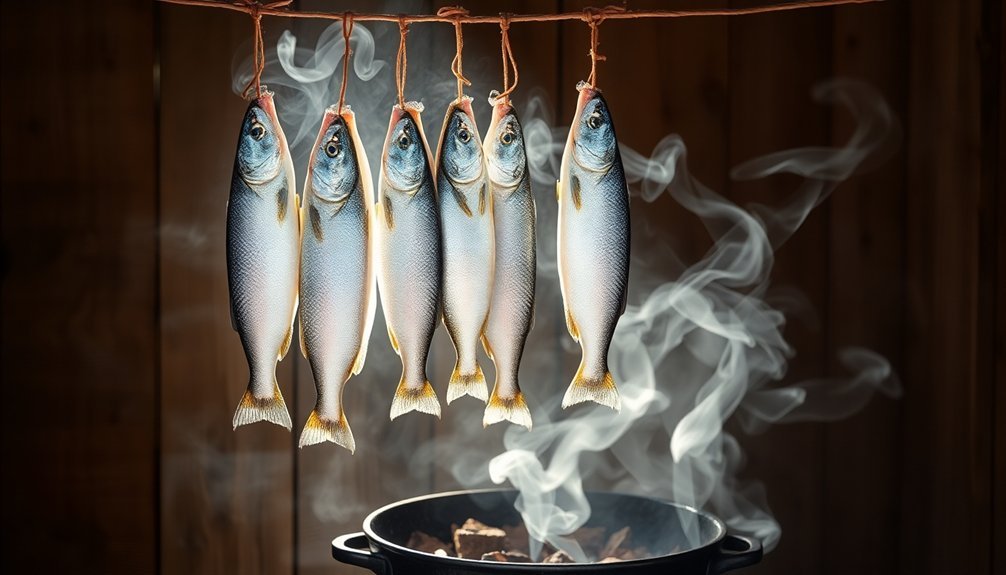
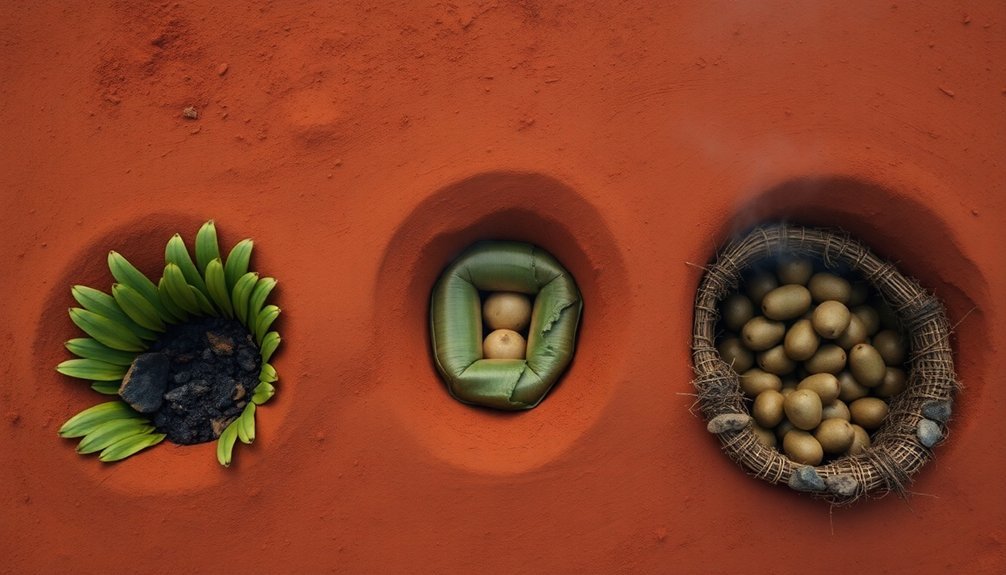
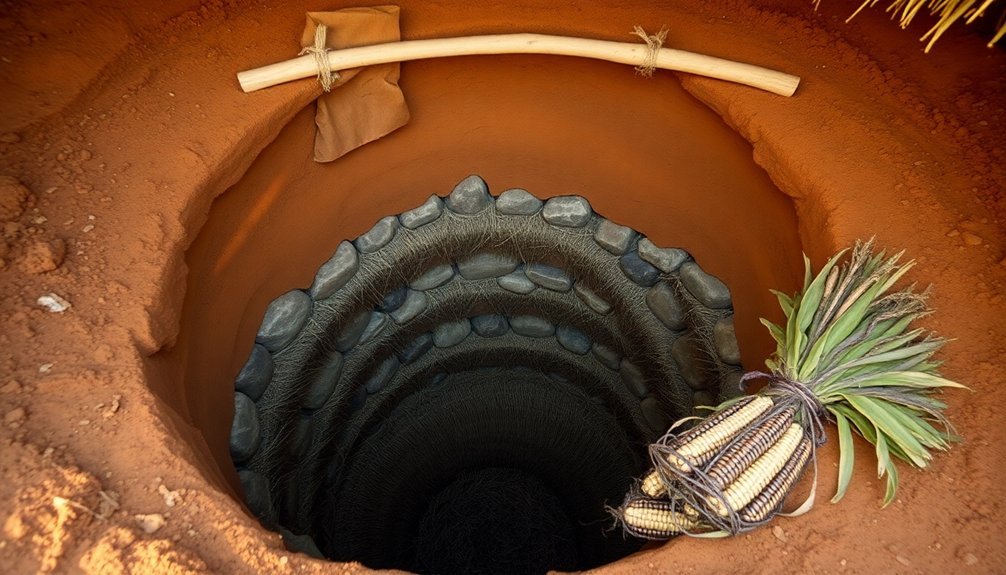
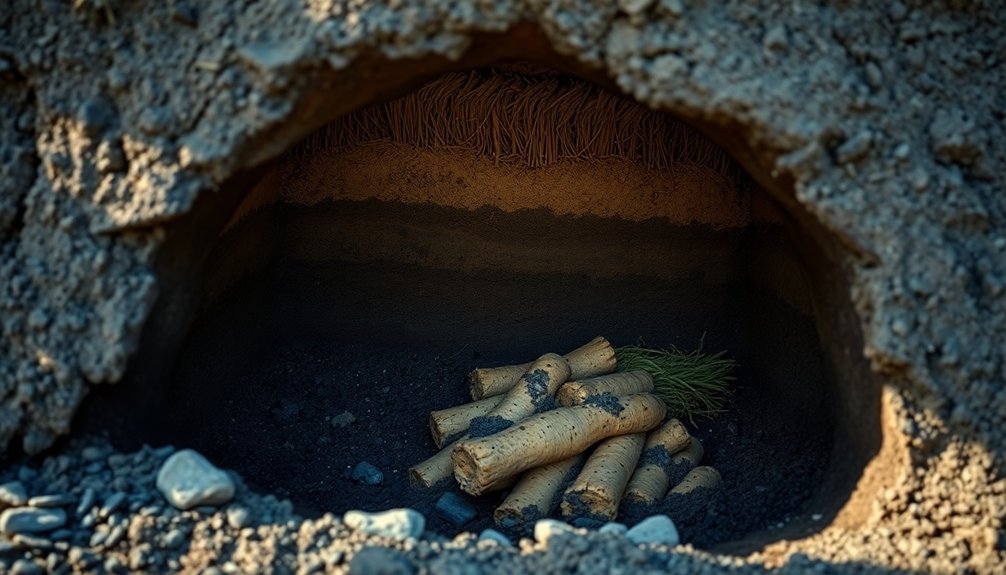
Leave a Reply